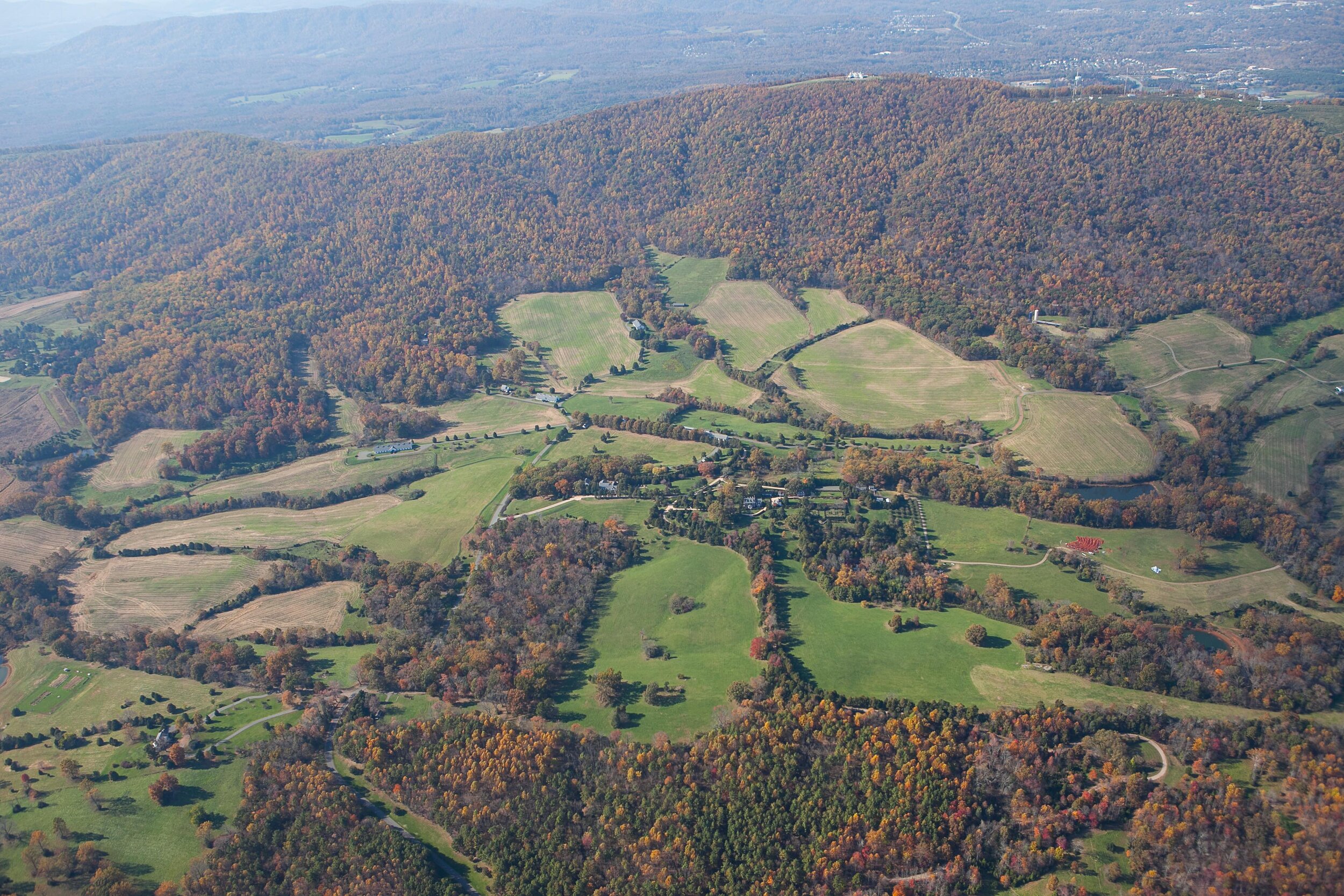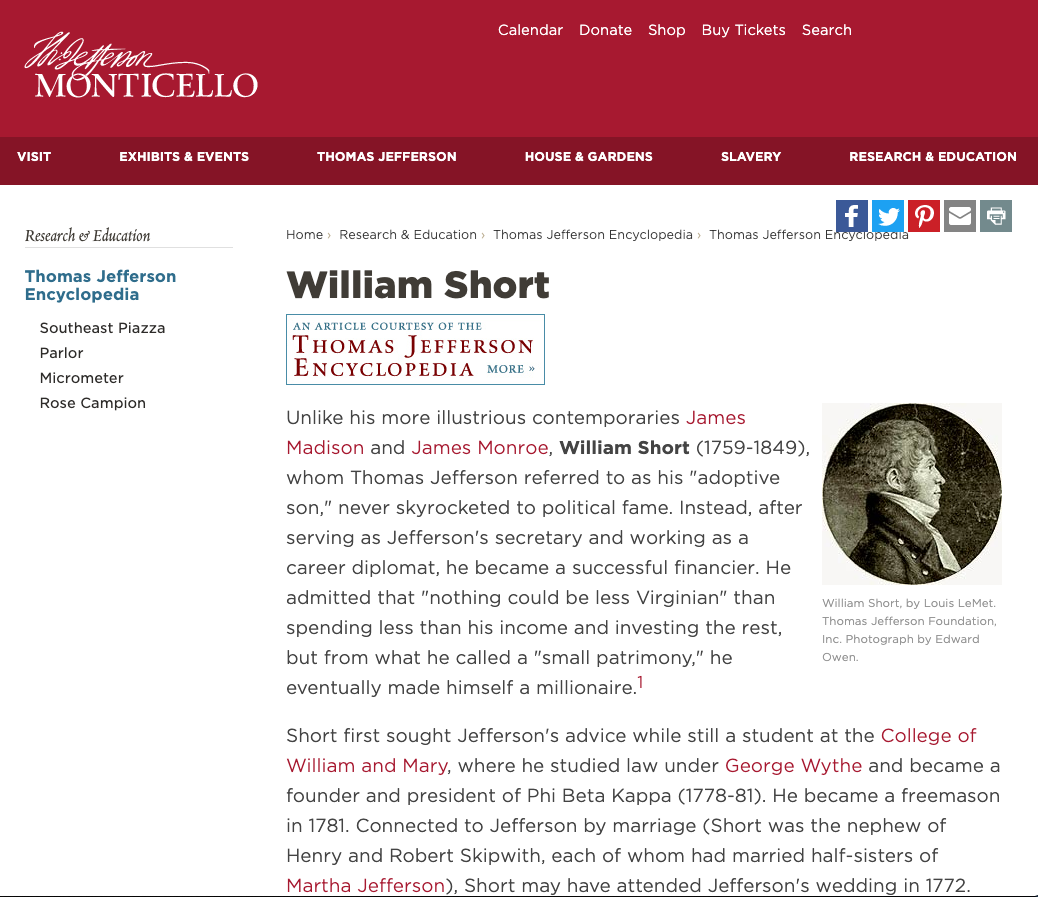
History Home Indian Camp & 19th Century 20th Century
“Indian Camp” & 19th Century
First Peoples/Native Presence 1000-1700s:
Monacan tribes lived in the Charlottesville area in the 17th Century, migrating westward with the arrival of European settlers.
Archaeological research conducted at Morven is contributing to our understanding of the native presence in this part of North America prior to European exploration and settlement. To date, three sites revealing prehistoric and historic-era land uses have been located on the Indian Camp Creek valley portion of the site. It was thought the site now known as Morven could potentially be a native homeland, however, evidence uncovered by archeology study found the site was more likely utilized as a seasonal hunting ground. While Rivanna Archeology and academic partners at UVA, Monticello, and Washington and Lee found significant evidence of Native peoples activity within the geological record of the site, what we know about Native Peoples activities at Morven is still limited, more information regarding Native American life in Albemarle County has the potential to be gathered by future phases of study.
“Indian Camp” 1795 - 1813
In 1730, land encompassing today’s Morven was part of a 9,350-acre royal land grant to John Carter, Secretary of Virginia Colony. Within this vast holding, a 1,334-acre section of the Carter family patent was called “Indian Camp,” presumably in reference to a Native American hunting ground located in the vicinity. Thomas Jefferson purchased the tract in April 20, 1795 on behalf of his “adoptive son,” William Short, to whom he wrote: “I bought the Indian Camp for you because you have expressed some partiality for our neighborhood and climate...there are no lands in this state of equal fertility and equal advantages….”
Short served as private secretary to Jefferson during his term as U.S. Minister to France from 1785-1789. Upon Jefferson’s departure, Short took a leading role in the American legation, and went on to serve as U.S. Minister to Holland and Spain in the 1790s, becoming American’s first career diplomat.
Jefferson managed the property, renting small plots to a number of tenant farmers. They utilized crop rotation methods developed by Jefferson to restore the soil from the detrimental effects of tobacco and corn crops. The map above, courtesy of the Huntington Library, shows the location of the tenant farms on the property known as "Indian Camp."
Jefferson deeded the property in 1813 to David Higginbotham, a leading merchant at the nearby port of Milton on the Rivanna River.
Morven in the 19th Century
In Memory of Rev. Lee Jones, Died Nov. 14, 1923, Aged 87 Years, “Loved by many Respected by all Saved by Grace”
Two radical visions—Thomas Jefferson’s scheme for sustainable agriculture through long-term leases and crop rotation, and William Short’s disdain for slavery—found expression in dozens of letters between the two men, discussing Short’s absentee ownership and Jefferson’s management of the property. Thomas Jefferson deeded the property in 1813 to David Higginbotham, a leading merchant at the nearby port of Milton on the Rivanna River. Higgenbotham transformed Morven’s tenant farming landscape into a large-scale slave plantation.
After Higginbotham’s death in 1853, his possessions, including his slaves, were auctioned. Auction records include the names of his slaves, including that of Lee Jones. Research conducted by Scot French and Lenora McQueen, a descendant of Lee Jones, UVA students were able to trace his life after emancipation. Other free and enslaved people remained at Morven for the duration of their lifetime, leaving much to preserve and honor about their lives and ancestors.
Letter from Francis Smith regarding the grave of Rev. Lee Jones: My Dear Sir – I enclose brief incscription for the tombstone of my friend Lee Jones. I asked permission of his family to erect a stone at his grave and understood that they agreed to it. But it would be safer to let them know that you were authorized to prepare and erect it. Francis Smith, University of Virginia, Dec. 13, 1923
Former UVA Faculty member, Scot French, spent several years studying enslaved life at Morven. He published a brief overview of Morven’s historical timeline for UVA’s School of Architecture, referenced below. The full timeline can be viewed on their website. Morven passed through two property owners from 1813 to 1853, who owned a large number of enslaved African Americans:
“1813-1853: David Higginbotham’s “Morven” Plantation/Antebellum Era. In this period the site was renamed Morven and transformed from small-scale tenant farming to large-scale plantation slavery. Key documents include letters written by white family members, an inventory of household goods and slaves, and maps showing site features and boundaries.
1853-1906: D.G. Smith & Descendants/Civil War, Reconstruction, and New South Eras. The demise of slavery and the transition of masters and slaves to employers and employees distinguish this period of site history. Researchers have begun to map the reconfigured racial geography and social relations at Morven in the post-emancipation era.”
In 1906 Morven was purchased by the Marshall family, who used Morven as an estate as opposed to a productive farm. It is unclear if the Smith family, who controlled Morven throughout the Civil War, had already made this change in the management of Morven, or if it functioned as a productive farm up until that time.
In 2013, former UVA President Sullivan initiated the President’s Committee on Slavery and the University commitments to delve into UVA’s history as an institution built on slave labor.
Recently, UVA President Jim Ryan asked the Racial Equity Task Force to create thoughtful and bold recommendations for racial equity at the University in response. A new website was created in order to amplify the call to action made by students, faculty, and community members through protests, petitions, and working groups over decades. To credit those activists and to contextualize the present moment, 50 years of documents addressing racial inequity at UVA were collected and compiled into an interactive library.
In the above presentation given May 31, 2016, Scot French explores land history at Morven Farm. Scot French was a former Associate Professor & Director at UVA’s Virginia Center for Digital History, as well as a Research Associate Professor at the School of Architecture.
The panel discussion above took place on October 19th, 2017 as part of the symposium “Universities, Slavery, Public Memory, & the Build Landscape,” hosted by the University of Virginia President's Commission on Slavery and the University and the Slave Dwelling Project. Lenora McQueen and Scot French discuss the history of Morven and Lenora’s research as a descendant of enslaved laborers at Morven.
In 2020, the Summer Jefferson Symposium held a talk by Justene Hill Edwards, Professor, Arts & Sciences, Corcoran Department of History, University of Virginia. The talk explores the differing perspectives of Thomas Jefferson and William Short, which illuminates the complicated political history of gradual emancipation and the early republican idea of property ownership as freedom.
The Flash Seminar above, “Legacies of Enslavement at UVA’s Morven Farm” took place on March 15, 2023 in partnership with the Carter G. Woodson Institute. Scot French and Lenora McQueen discuss Morven’s history, their research, and their Morven Summer Institute course: “Morven’s Enslaved and Descendant Communities.”
Related Reports & Studies:
Click the photos below to view these reports.
Research into enslaved life at Morven immediately before, during, and after the Civil War is ongoing, though the PDF’s below offer insight into the research that has been conducted thus far.
Land Timeline at Morven
1000 - 1700s First Peoples/Native Presence
1730 - 1796 Carter Family
1796 - 1813 William Short
1813 - 1853 David & Mary Garrigues Higginbotham
1853 - 1879 Daniel Groff Smith
1879 - 1906 Edward Buckey Smith (son of Daniel Smith)
1907 - 1923 Samuel H. & Josephine P. Marshall
1923 - 1926 David C. & Margaret G. Patterson
1926 - 1941 Charles A. & Mary L. Stone
1941 - 1987 Whitney & Anne Stone
1988 - 2001 John W. Kluge (retaining a life estate on the core property until 2006)
2001 - present University of Virginia Foundation

















